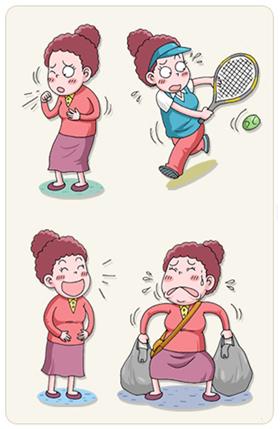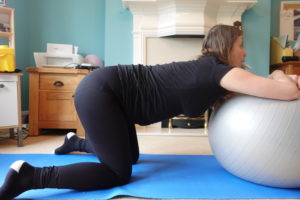In our previous blog posts and videos we saw How to Practice Sport Safely while Pregnant?
However, now you gave birth and baby is here for few weeks already, you feel less tired and you start to think about getting back to sport…
But how???
First let’s see: What are the risk of starting sport too soon after giving birth?
- Urinary incontinence
- Prolapse
- Anal incontinence
I know, it’s frightening but it’s to highlight the importance to understand what happen after giving birth and to follow some rules to prevent these issues!
What happen during physical activity?
When performing a physical activity continence (ability to hold urine) is maintain if the strength of your sphincter muscles (pelvic floor anatomy => here) is superior to the vesical pressure (=pressure inside your bladder).
If the pressure inside your bladder exceeds your sphincters strength, a leakage appears (also called stress incontinence). This increase of vesical pressure can be caused by:
- An increase of pressure within your abdomen. Caused for example by contraction of rectus abdominis (6 packs muscles)
- A strong impact (jump or even when running) bringing all your internal organ down against your pelvic floor
Ability to engage your sphincters muscles can be enhance by a voluntary contraction of the pelvic floor muscles (pelvic floor anatomy => here). Consequently, having a good control, sensation and strength of your pelvic floor is essential to prevent stress incontinence.

Why urine leakage appears during physical activity?
Mechanisms leading to stress incontinence in women athletes aren’t simply explain by a loss of pelvic floor strength. Even though intense sport activities don’t particularly strengthen pelvic floor muscles and impact sports (running, trampoline, gymnastic…) require stronger pelvic floor muscles, in these cases stress incontinence isn’t only due to a damaged pelvic floor.
In women athletes, stress incontinence would be a consequence of a lack of anticipation. In other words, postural muscles (transverse abdominis, deep erector spinae…) and pelvic floor muscles are not engaged prior to the effort. This lack of anticipated contraction lead to an increase intra-abdominal pressure above the strength of urethral sphincter causing urine leakage…
Furthermore, another parameter play an important role, pelvic floor muscles fatigability. After a training of 90 minutes maximal pelvic floor strength is reduced by 20%!
Finally, some sports have a tendency to stretch pelvic floor muscles and weakening it by increasing intra-abdominal pressure or by pushing apart ischial bones (bone you can feel when you sit, check our article on pelvic floor anatomy for more details)
In a lot of sport, intra-abdominal pressure is increased, pushing your abdominal organs downward against your pelvic floor muscles, which are not always strong enough to compensate these pressures.
How to prepare to go back to sport?
To prevent the issues mentioned above, a pelvic floor rehabilitation is essential prior to start physical activities.
Initially, you’ll have to restore an adequate pelvic floor strength. Only, if there is a weakness due to the pregnancy (but careful, in some cases, pelvic floor muscles are already too tense and on the contrary, they would need to be relaxed). To strengthen your pelvic floor muscles, you can use specific gymnastic/exercises (Abdo MG like on the video below) with the following progression:
- Repetition of quick contraction with maximal strength and long break between each (at least 10-15sec in between 2 contractions). Perform these pelvic floor training 4min each day
- Repetition of long (10-15sec) contraction with less strength but still long break between each (at least as long as the contraction). Perform these pelvic floor training 6min each day
- Start the above pelvic floor exercises lying on your back, then after few days (4 or 5), pass to sitting and then standing up.
The following two videos show how to start training your pelvic floor associating pelvic floor contraction and breathing. Really important to protect your abdomen after giving birth and even more after C-section!
In a second time, you would have to work on your pelvic floor control and perineal lock. But what is perineal lock???
It’s an anticipated contraction of your pelvic floor muscles prior to an increase of intra-abdominal pressure to prevent leakage / stress incontinence. So, it is not only about feeling where your pelvic floor muscles are but knowing when they are engaged and how/when to contract them. To start a biofeedback rehabilitation can help you to restore a good sensation and control of your pelvic floor muscles and then by practising it you will be able to automatize this perineal lock (like putting your hand in front of your mouth before to sneeze or cough).
Perineal lock is only efficient for a short effort (less than 60s) like coughing, sneezing, jumping, short run…
To train it, you’ll start by doing it for small and anticipated efforts:
- Exercise 1: I engage my pelvic floor muscles before to cough or sneeze
- Exercise 2: I engage my pelvic floor muscles before to jump (and I keep the contraction as I land on the floor)
As you learn the perineal lock, you’ll have to strengthen your transverse abdominis (with hypopressive gymnastic for example) to protect organs localised in your lower abdomen (bladder, uterus and rectum) and reduce push on your pelvic floor.

When and how to go back to sport?
Never practice impact sport before 6 weeks postpartum: your muscles and ligaments are still too weak after the pregnancy and the trauma of giving birth.
Never practice impact sport before you had a check-up with a Women’s Health Physiotherapist: and a pelvic floor rehabilitation if needed
After 6 weeks (and a thorough pelvic floor check!) you can gradually go back to your sport, if there is no medical contraindication (like C-section, episiotomy, incontinence…). All the mentioned contraindication necessitates a pelvic floor rehabilitation.
This progressive and gradual return to sport means you start by the same activity/intensity you were doing during the pregnancy not before! So, don’t go back running for an hour because it’s 6 weeks postpartum and you were doing it before to be pregnant 🙂
- Start with gentle sport (like swimming, yoga, fast walk) with no impact or important increase of intra-abdominal pressure
- For strenuous sports and impact sports: start with short sessions 10-15min for the first one and then increase by 5min each time if there are no symptoms (heaviness in your lower belly, urine leakage, difficulty to prevent vaginal or anal gas). If any of these symptoms appear, stop practising sport until you had a perineal check-up and a pelvic floor rehabilitation with a properly train women’s health physiotherapist.
- Leave 72h between two training at the beginning to leave time to your body to recover
For impact sports, change your shoes! Yes, your feet changed during pregnancy, they flatten and became longer. So, change shoes and insoles which are not adapted anymore!
If you are breastfeeding, it is advised to pump milk prior to practice your sport to avoid accumulation of lactic acid produced through physical activity.

Why you need to do sport?
I am presenting a lot of problems linked to sport not to fright anyone but on the contrary to help you to avoid any issue that would prevent you to enjoy an active life!
Sport is very beneficial for anyone and also after birth. Study even showed physical activity after giving birth reduce the risk of post-partum depression (Guidelines of the American College of Obstetricians and Gynaecologists for exercise during pregnancy and the post-partum period. Br J Sports Med 2003; 37: 6-12).
Go back practising your sport but do it wisely!
What are safe and more risky sports?
- Sports with higher risk (incontinence, diastasis…):
- Running
- Aerobic gym (fitness, Zumba…)
- Tennis
- Pilates when not done or adapted properly to the need of pregnant or postpartum women (which sadly is common…)
I am not saying here you shouldn’t do these sports, just be more careful with them and try to have your body (pelvic floor) ready before to start them!
- Sports with lesser risk
- Cycling
- Swimming
- Walk
- golf
INSEP (the French National Institute of Sport) published the following summary table:

In conclusion: Know your sport and related constraints and know/listen your body to prepare it gradually/adequately!




1 Response
Just to say, you don’t need to express before exercising. To produce lactic acid that enters breastmilk, you have to exercise very very very strenuously. I consulted a bf consultant ibclc.
https://kellymom.com/bf/can-i-breastfeed/lifestyle/mom-exercise/?fbclid=IwAR1UdKD1yWjt8rfUlcxFSf3i7qbayi40RVAtra4fK0a6YaAWPZEMe12Vn8k